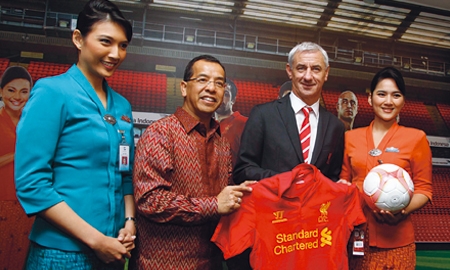The aviation sector in Indonesia is one of the fastest growing in the world. As such, there is huge demand for new infrastructure to alleviate the pressure on the already overstretched facilities in the traditional economic focal points of the west, as well as create new infrastructure in the relatively overlooked but resource-rich east of the archipelago.
Jakarta’s Soekarno-Hatta International Airport, managed by the Transport Ministry’s
Angkasa Pura II (
APII), is now the eighth busiest airport in the world. According to Airports Council International, in 2013 Indonesia’s main airport handled more than 62.1 million passengers.
The majority of Indonesia’s 27 international airports are undergoing expansion works and facility upgrades to meet rising demand and to prepare for the 2015 launch of the ASEAN Open Skies agreement, which grants open market access to all international airports in Southeast Asia to any airlines of the 10-member states.
“For Indonesia, the agreement presents both challenges and opportunities,” says Emirsyah Satar, President and CEO of Garuda Indonesia. “It will allow us more access to other markets but will also heighten the competitive nature of the industry. Leading up to 2015, we need to be prepared to compete with all ASEAN carriers.”
“Indonesia now is developing 20 new airports and some $500 million has already been pledged to improve the current facilities,” says Tommy Soetomo, President Director of
Angkasa Pura I (
API), which operates 13 airports in eastern Indonesia. “Indonesia’s traffic growth makes it very attractive for investment. I can assure you that it is a unique opportunity within Asia.”
Airport capacity is one of the largest challenges for Indonesia’s aviation industry. Soekarno-Hatta, for example, is having to cope with treble the passenger numbers of its original design and is currently undergoing a major remodelling and expansion. By next year, for example, capacity at Terminal 3 will have expanded to 25 million, up from its current 4 million.
According to Angkasa Pura II, ongoing and upcoming work on terminals 1 and 2 will raise capacity by 8 million and 10 million, respectively. The medium-term goal is to raise the airport’s capacity to nearly 90 million.
Pending is the approval of the master plan to construct a third runway at Soekarno-Hatta, which will allow the airport to handle up to 100 take-offs and landings per hour.
| Work is underway to expand Soekarno-Hatta to meet the current passegner traffic demand, which is already three times over the originally designed capacity |
Apart from Jakarta’s international airport, Angkasa Pura II also manages 12 other airports in western Indonesia and had a very busy 2013. “We have built new terminals at several airports, including Sultan Syarif Kasim II International Airport in Pekanbaru, Riau, and Raja Haji Fisabilillah Airport in Tanjung Pinang, Riau Islands,” Tri Sunoko, President Director of APII, says.
Other notable developments are under way nationwide, particularly in Bali and Sumatra, whilst the new Kuala Namu International Airport near Medan in northern Sumatra was inaugurated last July.
Renovations are ongoing on airports of all sizes, however. “We are also developing small airports including airstrips, especially for the eastern part of Indonesia, like Papua and the Moluccans – not only to expand tourism, but more importantly for accessibility,” comments Deputy Minister of Transport, Dr Bambang Susantono. “In this part of Indonesia most of the staple food is mainly transported by air.”
API has plans to build three more runways at Surabaya’s (East Java) Juanda International Airport by 2017. Last autumn, the operator completed an IDR 3 trillion facelift for Ngurah Rai International Airport in Denspasar, Bali. Furthermore, it is creating an entire ‘airport city’ around it, which will feature a new hotel and entertainment district, as well as retail, business, industry, warehousing and logistics.
Garuda Indonesia, reaching for the stars
Indonesia’s airports aren’t the only sector players growing their activities and assets. PT
Garuda Indonesia (Persero) set out its own strategic expansion plan a few years ago in the Quantum Leap 2011-2015 programme, which focuses on transformation in all business aspects to give more value to customers, with improved safety and profitability, fleet revitalisation and flight network expansion.
“This way, the airline is able to connect all airports in Indonesia, while bringing Indonesia to the world,” says Garuda CEO, Mr Satar. “It is aligned with our mission as the flag carrier of Indonesia that promotes Indonesia to the world.”
In May, the carrier is opening new non-stop flights to Amsterdam, which nearer the end of 2014 may possibly be extended to London Gatwick. The route will be serviced by an Airbus A300-ER, which according to Mr Satar is “equipped with in-flight connectivity and an on-board chef. First-class passengers will be able to enjoy a different experience by ordering special meals from the chef.”
The network expansion plan is in line with the company’s aircraft development programme, as Garuda Indonesia takes delivery of various new aeroplanes, thus adding to its 114-strong fleet and lowering the average age of 5.6 years even further. Over the next decade, it may purchase some 250 new aircraft.
The carrier’s transformation programme has earned Garuda the appreciation from numerous international institutions that have bestowed the airline with a number of prestigious awards.
These include “World’s Best Regional Airline” from Skytrax (London) and “Best International Airline” from Roy Morgan (Australia) in 2012. Last year, the ‘Four Stars Airline’ was also named “ASEAN Premium Airline of the Year” by Frost & Sullivan, “World’s Best Economy Class” by Skytrax and “Best in Region: Asia & Australia” at the Passenger Choice Awards.
Certainly of no less importance for passengers, Garuda also took first place in the first-ever Asia Pacific Airline Food Awards.

0 COMMENTS